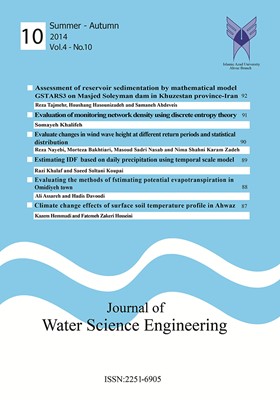Evaluation of monitoring network density using discrete entropy theory
محورهای موضوعی : Irrigation and Drainage
1 - مهندسی منابع آب، گروه مهندسی آب، دانشگاه شهید باهنر کرمان،ایران.
کلید واژه: ارزیابی, آنتروپی گسسته, تراکم و شبکه باران&lrm, سنجی,
چکیده مقاله :
The regional evaluation of monitoring stations for water resources can be of great importance due to its role in finding appropriate locations for stations, the maximum gathering of useful information and preventing the accumulation of unnecessary information and ultimately reducing the cost of data collection. Based on the theory of discrete entropy, this study analyzes the density of rain gage stations in Zohreh Basin located in Fars Province, Iran. Considering the marginal entropy index H(x), joint entropy H(x, y), information send index S(i) and received index R(i) of each station and information transfer index (ITI) between stations, important stations and weak areas of information transfer have been determined in the monitoring network of the basin and spatial interpolation has been calculated. The results showed that the density of the rain gage monitoring network is acceptable. The calculated values for the indexes of R(i) and S(i) are completely parallel and each station receives almost the same amount of data that it sends to other stations. Finally, two new indexes of NH (x) and NH (xˆ(i)) produce equivalent results with R(i) and S(i) indexes. The obtained results showed that 3 stations Noorabad, Baraghan and Ghoshneghan are in the crisis condition and had been and replace it there. also due to the nature of the statistical method, removing of mention station without cheking hydrological conditions and how of hydrograph combination is recommended.
ارزیابی منطقه ای ایستگاه های پایش منابع آب به دلیل اهمیت آن در مکان یابی مناسب ایستگاه ها، جمع آوری حداکثر اطلاعات مفید و جلوگیری از انباشت غیر ضروری اطلاعات و نهایتاً کاهش هزینه های جمع آوری اطلاعات حائز اهمیت فراوان است. در این پژوهش بر پایه تئوری آنتروپی گسسته، تراکم ایستگاه های باران سنجی حوزه آبخیز زهره فارس مورد بررسی قرار گرفته است. با در نظر گرفتن شاخص های آنتروپی مرزی (H(x))، آنتروپی مشترک (H(x,y))، شاخص های اطلاعات ارسال شده(S(i)) و دریافت شده (R(i)) توسط هر ایستگاه و شاخص انتقال اطلاعات بین ایستگاهها (ITI) به تعیین ایستگاه های مهم و مناطق ضعیف از نظر تبادل اطلاعات در شبکه پایش حوزه آبخیز پرداخته و پهنه بندی انجام شد. نتایج پهنه بندی با استفاده از نرم افزار ArcGIS 9.3 نشان داد نشان داد که تراکم ایستگاه های شبکه باران سنجی قابل قبول می باشد. مقادیر محاسبه شده برای شاخص های R(i) و S(i)کاملاً هم ارز بوده و هر ایستگاه تقریباً به همان میزان که اطلاعات به سایر ایستگاه ها ارسال میکند، اطلاعات دریافت می نماید. دو شاخص جدید NH(x) و NH()نتایج هم ارزی با شاخص های R(i) و S(i) تولید و ارائه می نمایند. در نهایت نتایج بدست آمده از ارزشیابی منطقه ای ایستگاه ها نشان از آن دارد سه ایستگاه نورآباد، برغان و گشنگان ضمن کسب رتبه های پایین در شبکه، وضعیتی بحرانی داشته و ادامه فعالیت آنها مستلزم تجدید نظر جدی است. البته با توجه به ماهیت آماری روش گفته شده، حذف یا جابجایی ایستگاه های یاد شده بدون بررسی شرایط هیدرولوژیکی و چگونگی تلفیق هیدروگراف ها در شبکه آبراهه ای پیشنهاد نمی شود.
خلیفه، س. و خلیفه، ا. (1393). ارزیابی منطقهای ایستگاههای پایش هیدرومتری حوزه بختگان- مهارلو با استفاده از تئوری آنتروپی. فصلنامه تخصصی علوم و مهندسی آب، شماره 6، ص: 29-46.
فانی، م. و افلاطونی، م. و جاهدی، غ.(1391). ارزیابی شبکه ایستگاههای بارانسنجی حوزه آبخیز کارون بزرگ با استفاده از تئوری آنتروپی گسسته، پایان نامه کارشناسی ارشد، دانشگاه آزاد اسلامی، شیراز.
کریمی حسینی، آ. و بزرگ حداد، ا. (1388). ارزیابی و طراحی شبکه ایستگاههای بارانسنجی حوضه باتلاق گاوخونی با استفاده از تئوری آنتروپی و الگوریتم ژنتیک. دهمین سمینار سراسری آبیاری و کاهش تبخیر، دانشگاه شهید باهنر کرمان، ص62.
معصومی، ف. وکراچیان، ر.(1387). بهینهسازی مکانیابی ایستگاههای پایش کیفی منابع آب زیرزمینی با استفاده از تئوری آنتروپی. مجله آب وفاضلاب، شماره 65، ص 12 -2.
Chen, Y. C., Weiand, C. and Yeh, H. C. (2008). Rainfall network design using kriging and entropy.Hydrological Processes, 22, pp. 340-346.
Husain, T. (1989). Hydrologic uncertainty measure and network design. Water Resources Bulletin, 25, pp: 527-534.
Krstanovic, P. F. and Singh, V. P. (1988). Application of Entropy theory to multivariate hydrologic analysis. Vol. 1. Technical Report WRR9, Water Resources Program, Dept. of Civil Engineering, Louisiana State University, Baton Rouge, 271 p.
Krstanovic, P. F., and Singh, V.P. (1988). Application of Entropy theory to multivariate hydrologic analysis. Vol. 2. Technical Report WRR9, Water Resources Program, Dept. of Civil Engineering, Louisiana State University, Baton Rouge, pp: 271-557.
Kawachi, T. (2001). Rainfall entropy for delineation of water resources zones in Japan. Journal of Hydrology, 246, pp: 36-44.
Mishra, A. K. and Coulibaly, P. (2010). Hydrometric network evaluation for Canadian watersheds. Journal of Hydrology, 380, pp: 420-437.
Markus, M., Knapp, H. V. and Tasker, G.D. (2003). Entropy and generalized least square methods in assessment of the regional value of stream gages. Journal of Hydrology, 283, pp: 107-121.
Mogheir, Y., Lima, J. L. and Singh, V. P. (2004). Characterizing the special variability of groundwater quality using the entropy theory. Hydrological Process, 18, pp: 2165-2179.
Mogheir, Y. and Singh, V. P. (2002). Application of information theory to groundwater quality monitoring system. Water Resources Management, 16(1), pp: 37- 49.
Mogheir, Y. and Singh, V. P. 2003. Specification of information needs for groundwater management planning in developing country. Groundwater Hydrology. Balema Publisher, Tokyo, 2, pp: 3-20
Mondal, N. and Singh, V.(2012). Evaluation of groundwater monitoring network of Kodaganar River basin from Southern India using entropy.Environmental Earth Sciences, 66 (4), p. 1183-1193.
Shannon, C. E. (1948). A mathematical theory of communication. Bell System Technical Journal, 27, pp. 379-423.
Sarlak, N. and Sorman, A. (2006). Evaluation and selection of streamflow network stations using entropy methods. Turkish J. Eng. Env. Sci, 30, pp. 91-100.
Yang, Y. and Burn, D. (1994). An entropy approach to data collection network design. Journal of Hydrology, 157, pp:. 307–324.


